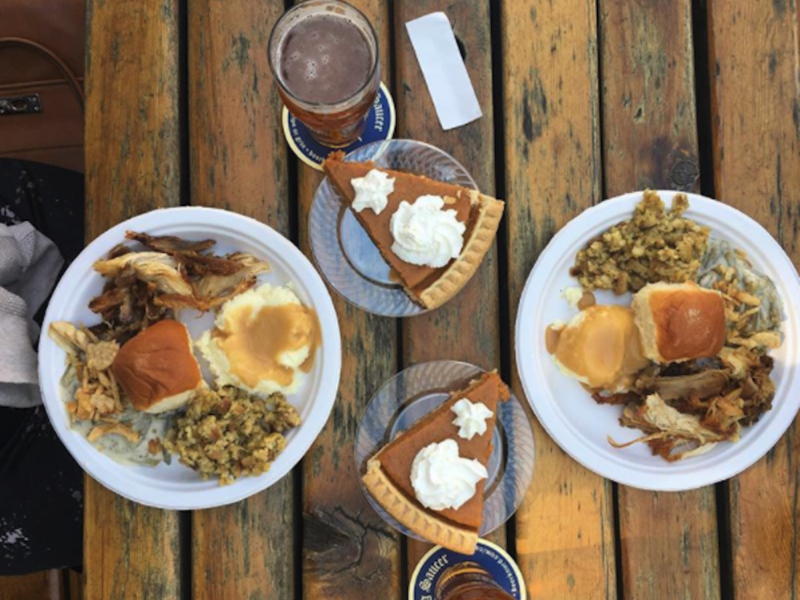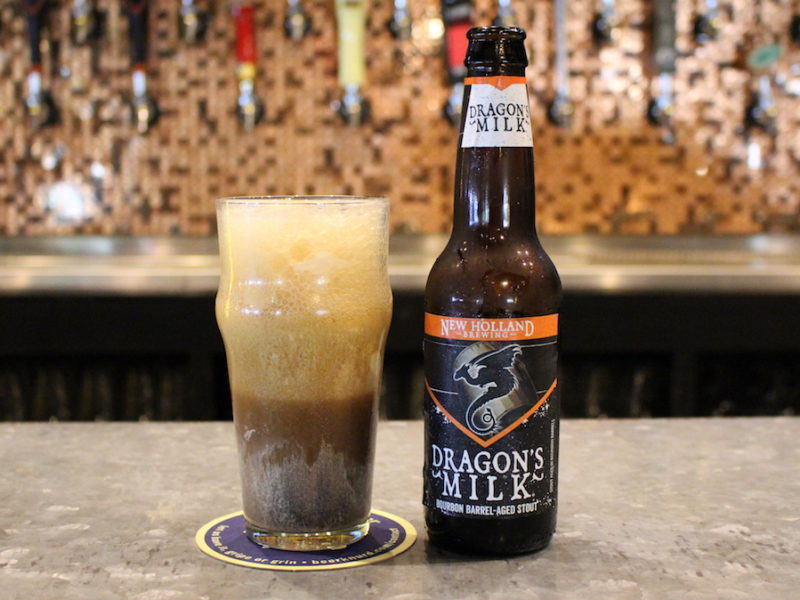You could say Stephen Beaumont knows a few things about beer. He has 10 books, an audiobook, countless articles and over 25 years as a professional beer writer to prove it. He hosts beer tastings, beer dinners, educational events and consults with a whole host of people in the hospitality business about everything from beer list construction to bar design. He also has a freaking James Beard Award nomination for Beer and Spirits Writing. So, yeah, you could definitely say he knows his stuff.
You could also say he’s one of the most affable people in beer today. Stephen sat down with Beerknews before a beer dinner at Flying Saucer sister restaurant Meddlesome Moth to chat about everything beer and food-related, including his least favorite food.
Where did the idea of writing about beer and food pairing spring into your head?
Well, “The Beer & Food Companion” is my 10th book, but the idea first came to me very early on, when I was actually kind of learning all about beer and learning how to taste.
I was combining flavors together and finding that they actually work better when they’re together than they do even separately. So, you take two great tastes and make them even better when they pair off each other. This was fascinating to me, and I started doing some of that.
The first beer and food pairing I hosted was in 1993 and that was a beer and chocolate pairing. And the whole audience was skeptical. Nobody believed this was going to work but it, it really did work. And then, in 1995, I published “A Taste for Beer,” which had a whole chapter on beer and food pairing, and that’s where I started this whole thing.

Beaumont’s latest book, THE BEER & FOOD COMPANION. Out now!
image credit: @BeaumontDrinks
Would you consider yourself a beer snob?
Um, yeah. I embrace that term. I’m not a snob in the sense that I care about what you’re drinking, what she’s drinking, what the guy down the bar’s drinking. I care about what I’m drinking. I just don’t want to pay money for beer that I don’t really want to drink just because it’s beer.
Would you consider yourself a food snob?
Again, it depends on the definition of “snob.” I like food that tastes good. I don’t find any joy in a Big Mac. The flavors don’t appeal to me. I just don’t like food that doesn’t taste like anything other than filler.
So when I eat at a place like the Meddlesome Moth or beerbistro in Toronto—which I helped found—that cares about the beer and cares about the food, that excites me. That, to me, is the ultimate destination. And there are a lot more places that do that now than there were even five years ago.
Where do you place the current hot spots for beer in America?
In America? Geez. Pretty much everywhere.
In the last few years, I’ve been to the Milwaukee area and there’s a lot going on there. And there’s a lot going on down in Dallas. Two hours down the road from me [in Toronto] in Buffalo, New York, that city is now having a brewery renaissance.
I really appreciate a place like Philadelphia, where you can just walk around to, not necessarily a brewery, but to great bars. Asheville, North Carolina, my gosh, you can do a dozen breweries in an afternoon. They’re good breweries, too. Not many duds in Asheville. I was down there last year and I was amazed at the South Slope District. I mean, you’re walking around the corner and there’s a brewery, and around the corner there’s another brewery, and around the corner there’s another brewery. It’s just crazy.
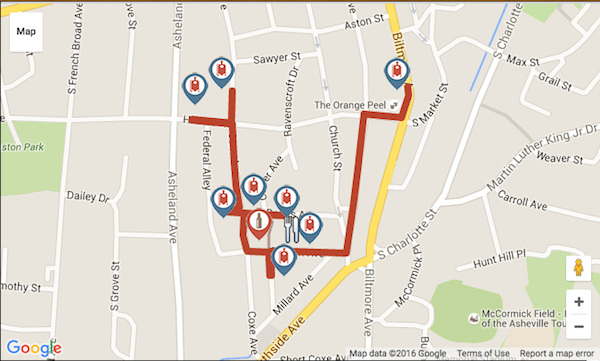
Asheville’s South Slope District
image credit: AshevilleAleTrail.com
Some people say that’s evidence of a bubble forming. Do you see it as a bubble? Do you think it will burst? If so, when?
There’s not going to be a burst. The situation right now is that there are a lot of breweries in the United States. Over 4,200 we know about. If you take it on a per capita basis, the US is still lower than places like Canada, the UK, Belgium and Switzerland. I mean, there are a lot of countries that have a lot more breweries per capita. And they’re still growing.
And the people you hear talking about the beer bubble are in markets that are incredibly saturated. San Diego is a monster market. Portland, Oregon is a monster market. There’s a line of brewery saturation there. That’s the perspective they’re coming from, because they’re seeking to continue to expand these businesses. But I think that a lot of the new breweries that are opening up do not have that mindset that they want to be a national brewery in 10 years.
When was your first food and beer pairing “ah-ha” moment?
Oh. There have been so many through the years. Choosing an “ah-ha” moment is just, I mean, we’re going back 20 years! That’s a long time for this guy to go back in his memory. I think there are always so many opportunities for “ah-ha” moments.
Here’s an “ah-ha” moment for you. Brie de Meaux from France, unpasteurized Brie with an oatmeal stout. Gorgeous! It’s a lovely thing! I’m working on a new book concept with the publisher of “The Beer & Food Companion,” and I told my editor that I want to do an entire chapter on beer and cheese. Just having fun with beer and cheese. I think there’s so much there.
“I’m not a snob in the sense that I care about what you’re drinking, what she’s drinking, what the guy down the bar’s drinking.”
You’ve spoken about bar snacks and beer being a poor pairing. What do you think is the most abused, misused, misunderstood pairing?
The whole bar snack thing stems from the fact that most bar snacks are salty, fatty, spicy. Beer has two elements going for it in terms of pairing. One is effervescence, which pretty much every beer has, and the other is hoppiness.
Where it all goes terribly, terribly wrong is when you have something like Firestone Walker Velvet Merkin, which is not an overly hoppy, overly carbonated beer and the salt of something like a bowl of chips. The salt will start to erode the quality of that malt. Abbey Style Ales can’t combine with salts, spice or fats. Those, they don’t do well because they don’t have that high carbonation, they don’t have that hoppiness that really cuts through.
And what I like to do sometimes when I do tastings is good and bad. So, do five simple foods, like a pretzel, a piece of cheese and then what each pairing will have is one that really works and one that’s terrible. Because I find that people are going to learn more from having a terrible beer and food pairing than they do from having a great one.
What do you think is the most misunderstood thing about beer?
For example, Greg Koch says that he wants to teach people that beer is more than just fuzzy, fizzy yellow stuff. Garrett Marrero from Maui Brewing Company says that he wants to convince people that bitter beer isn’t bad. Is there a common convention or is there something that you want to try to convince people of to help them better appreciate beer?
Well, first of all, I think we should convince more people that bitter beer is bad because we’re running out of hops. And that’s going to become an issue over the next period years.
What I like to tell people about beer is that it’s what you want it to be. It can be a wonderfully refreshing, thirst-quenching thing. I mean, a pilsner is, technically, a fizzy yellow beer—with all due respect to Greg. There are a lot of days where all I want is a good pilsner. And that’s a beautiful thing.
“…I think we should convince more people that bitter beer is bad because we’re running out of hops. And that’s going to become an issue over the next period years.”
Beer can also be a great bonding companion. Beer can be something to toast friendship. Beer can be anything you want it to be. All other alcoholic beverages have some kind of “stigma” that goes along with them. Like, you don’t say to your friend, “Hey, let’s go out after work and grab a couple martinis.” You say, “Let’s all go out for a beer.” I mean, you have martinis, but the invitation is “let’s go out for a beer.”
Who are some of your favorite chefs and restaurants?
I’m a big fan of really good food without a lot of pretense around it. There’s a guy in Montreal named Martin Picard, and he runs a restaurant called Au Pied de Cochon, “The Pig’s Foot,” which is a beautiful combination of casual dining and exceptionally good food. It is really one of my favorite restaurants in the world. But I get to travel enough, thankfully, that I get to taste a lot of great food and to highlight any one restaurant or chef over any dozen of others seems unfair.
Do you have an Achilles heel for any foods or beers?
Are there any foods that no matter how much you love food or beer and however many times you try them, you just don’t fully enjoy them? For example, olives, cilantro or sour beer. So many people love them, but so many people—for whatever reason—just can’t stand the way they taste.
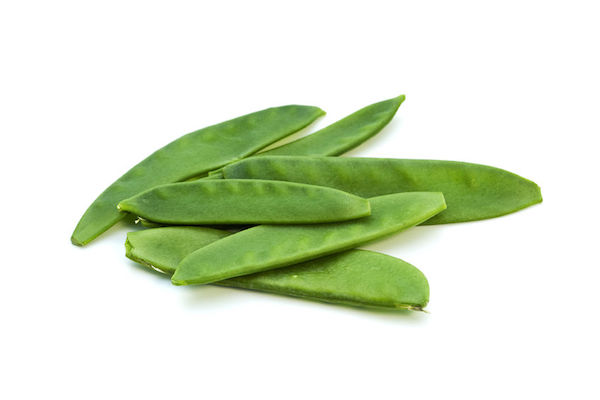
“I don’t really like snow peas. I am sure there is a chef out there that is doing a recipe with snow peas that I would absolutely adore but I’m not a big fan.”
There are very, very few foods that I don’t like. I’ve eaten almost everything that has been put in front of me—and there have been some very weird things put in front of me. I’m a sucker for French food. I’m a sucker for southern BBQ. I don’t really like snow peas. I am sure there is a chef out there that is doing a recipe with snow peas that I would absolutely adore but I’m not a big fan.
I will add one bit of advice as far as olives go: put a mix of green and black into a little ramekin and microwave them for about 30 seconds. Just to get a nice heat inside the core and they are delicious. This is what restaurants do — well, maybe not the microwave, but they serve warm olives and that enables them to charge like $8.
What if you think your palate just isn’t built for it?
I trained myself to taste and trained myself to think about beer. And I think that the way I trained myself to taste—and no such training existed in North America at the time—it allowed me to kind of approach every beer with a way of dissecting it. So people say, “What’s your favorite beer style?” My answer is always: good. There is no beer style that I dislike because I can find the merit, I can find all the plusses or minuses in every beer that I taste.
And when those plusses are way, way outweighing the minuses, that means I have a great beer in my hand.
“So people say, “What’s your favorite beer style?” My answer is always: good.”
Did you study to understand the theory behind the beer? How the beer was made? Why the beer was made? Is that part of it?
I think context is important, so, yeah—that does figure into it, but at the same time, the average beer drinker is just picking up that beer and tasting it. And I got a very important lesson early on in. I was at a tasting with a bunch of wine guys and we were tasting primarily wines but there were a few beers at the end. And this is back when Leifmans Goudenband was a great beer. And I stopped one of the wine guys who was writing a scathing review of that beer. He just simply hated it and I had to explain it to him and once I explained it to him he went back and tasted it and he understood it. That was an “ah-ha!” moment.
What do you feel is the most underrated style of beer?
I would say Kölsch. I don’t think that you can ever understand a Kölsch until you go to Cologne. And I know personally I did not until I went to Cologne myself. You drink it there and it’s a totally different animal, and you can also walk from one Kölsch house to the next and you can start to see that there are dramatic difference between these beers. They really are impressively different.

“I said ‘There is something wrong with your Kölsch.’ And his eyes just opened and he said ‘What do you mean?’ I said, ‘This actually tastes like a Kölsch.'”
image credit: New Holland Brewing
Do American Kölschs come anywhere near an authentic Kölsch from Cologne?
From time to time you do, you do come across them. I always encourage brewers to refer to their beers as “Kölsch-style” ales because I respect the appellation. I remember drinking the Kölsch-style beer at the New Holland brewery in Michigan and the brewer was there and I said “There is something wrong with your Kölsch.” And his eyes just opened and he said “What do you mean?” I said, “This actually tastes like a Kölsch.”
He didn’t hit me but he would have been within his right to if he wanted.
What was the last “cool” thing you learned about either beer or food or maybe the two together?
I think I’ve really discovered an appreciation for Helles Lager. I’ve come across a number of really good ones lately. You know, you go to a bar and every bar has 20 IPAs, and then half that number of double IPAs, and all this kind of stuff. And everyone wants to do sour beers and all sorts of new stuff. And to come across a really nice Helles is like a breath of fresh air. It really is a lovely thing. I think that’s not a discovery but it’s a rediscovery.
Beer people—yourself included—tend to be the coolest, nicest, most generous and humble people. Why do you think that is?
Well, one of the things that I continually mention to people is that I’m honored and humbled to be able to participate in this industry because the people that I meet are just as you said. It’s just a great industry. People open breweries, yes, because they see business potential in it. If they didn’t, they would be idiots. But they have a passion for what they are doing. They have a sense of purpose. I just think that it kind of reflects what beer is itself.
“I try to put everything into the context of what it would be like to have this beer at a bar, to have this beer with a meal, to have this beer in whatever context it should be had in.”
And it’s funny you mention that, because just today, I read a story online about “Why are beer people so mean?” But it was about the people online. I think this is the flip side of that. The great people who are behind beer, who are working in beer bars, who are running breweries, are the guys who reflect the nature of beer. And then there are those who sit in their basements, sipping one bottle of beer among eight people to make their latest notes and all this kind of crap, and I think that they are missing the point.
I try to put everything into the context of what it would be like to have this beer at a bar, to have this beer with a meal, to have this beer in whatever context it should be had in. And I think that there are a lot of people who are out there now who are missing that. They’re just talking about, “Wow, this is a cool little beer. I had two ounces of it shared with, you know, these other guys.“ And so the rare beers become, by definition, the “great” beers, because no one is going to stand in line for 12 hours for a beer that turns out tasting like shit. So it’s got to be good if they stood in line for 12 hours.
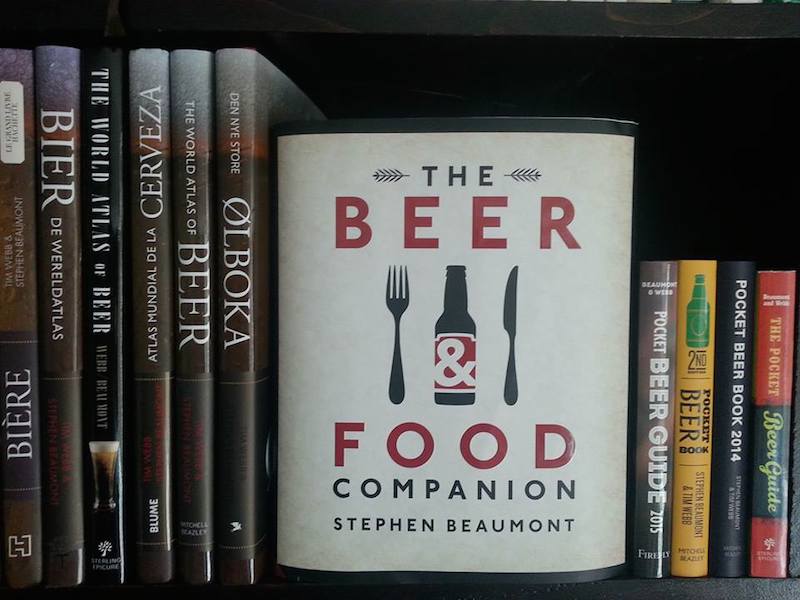
A small sampling of some of Stephen’s books in the wild.
image credit: Stephen Beaumont Facebook
If you’re looking for incredible beer enlightenment and inspiration for your next dinner party, check out any of Stephen’s books. You will not go wrong under his guidance.






